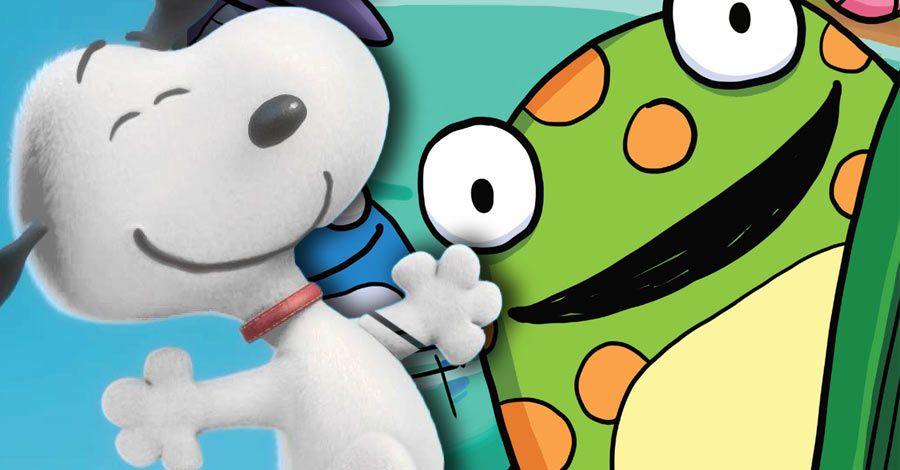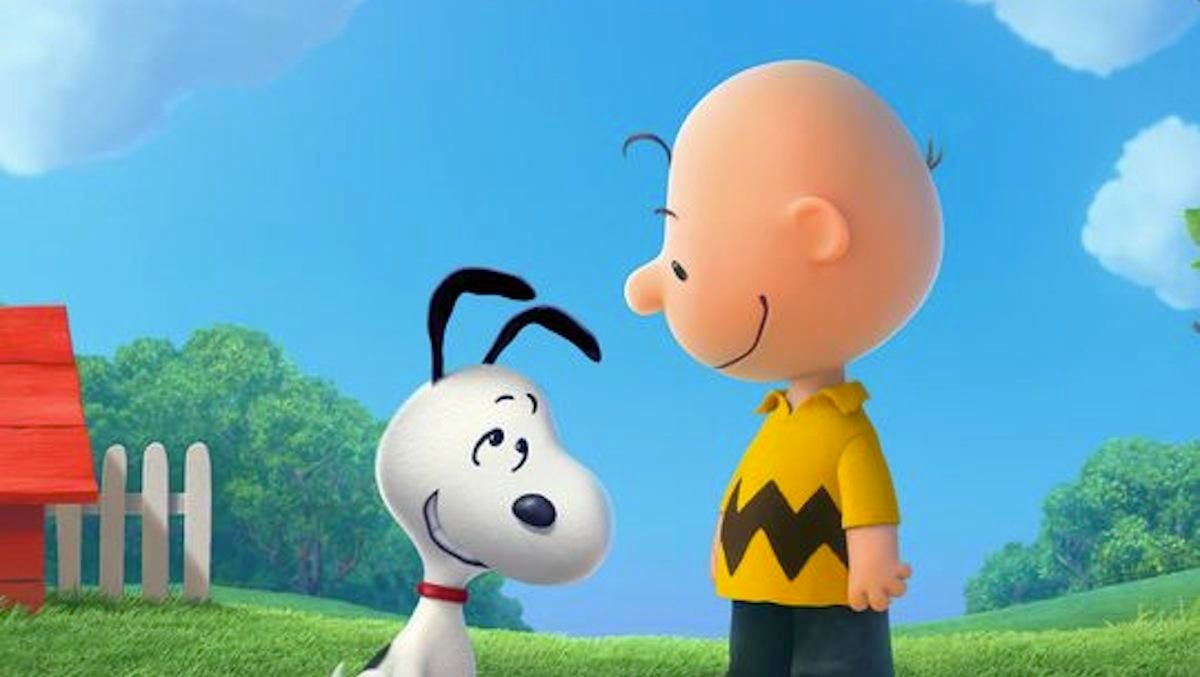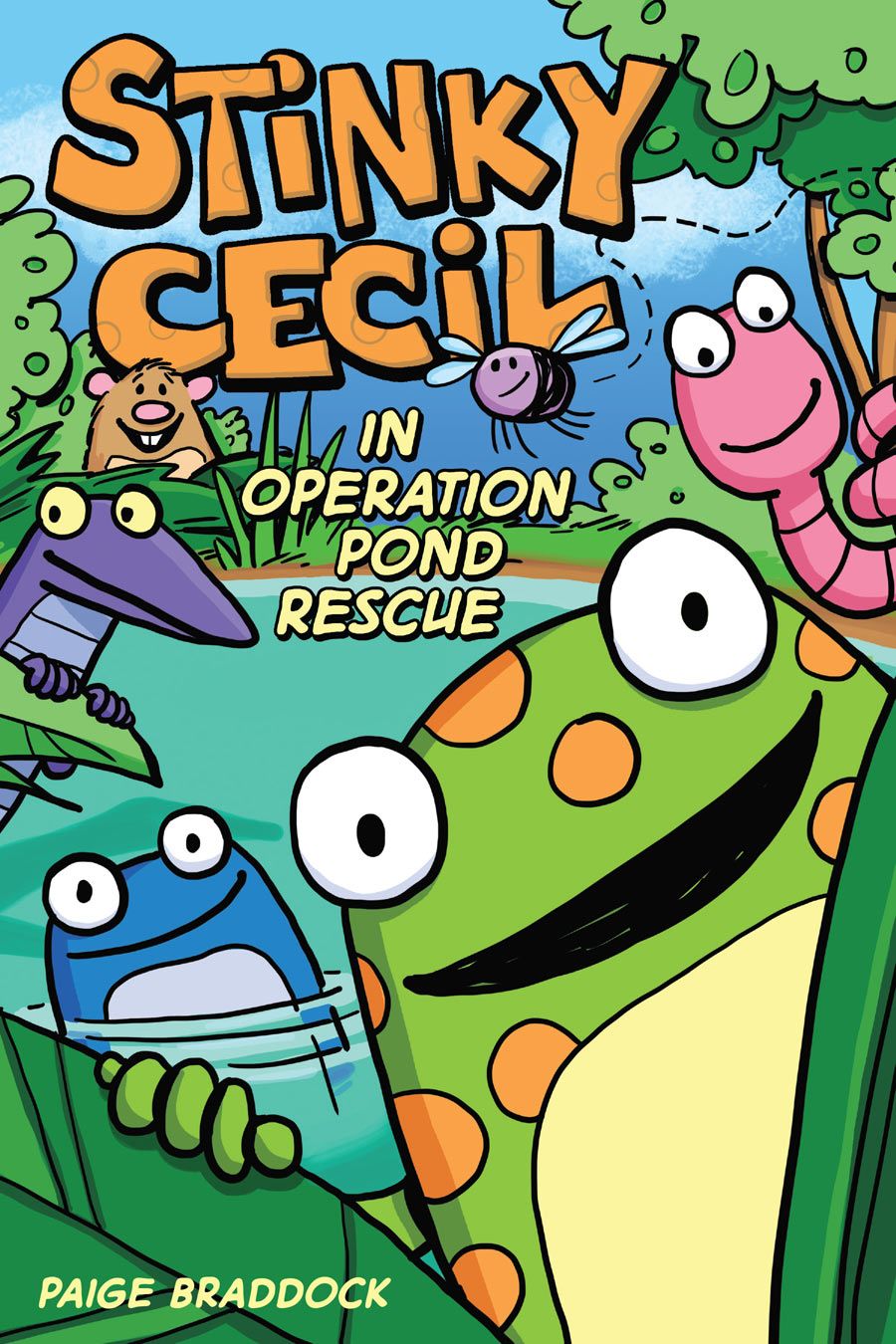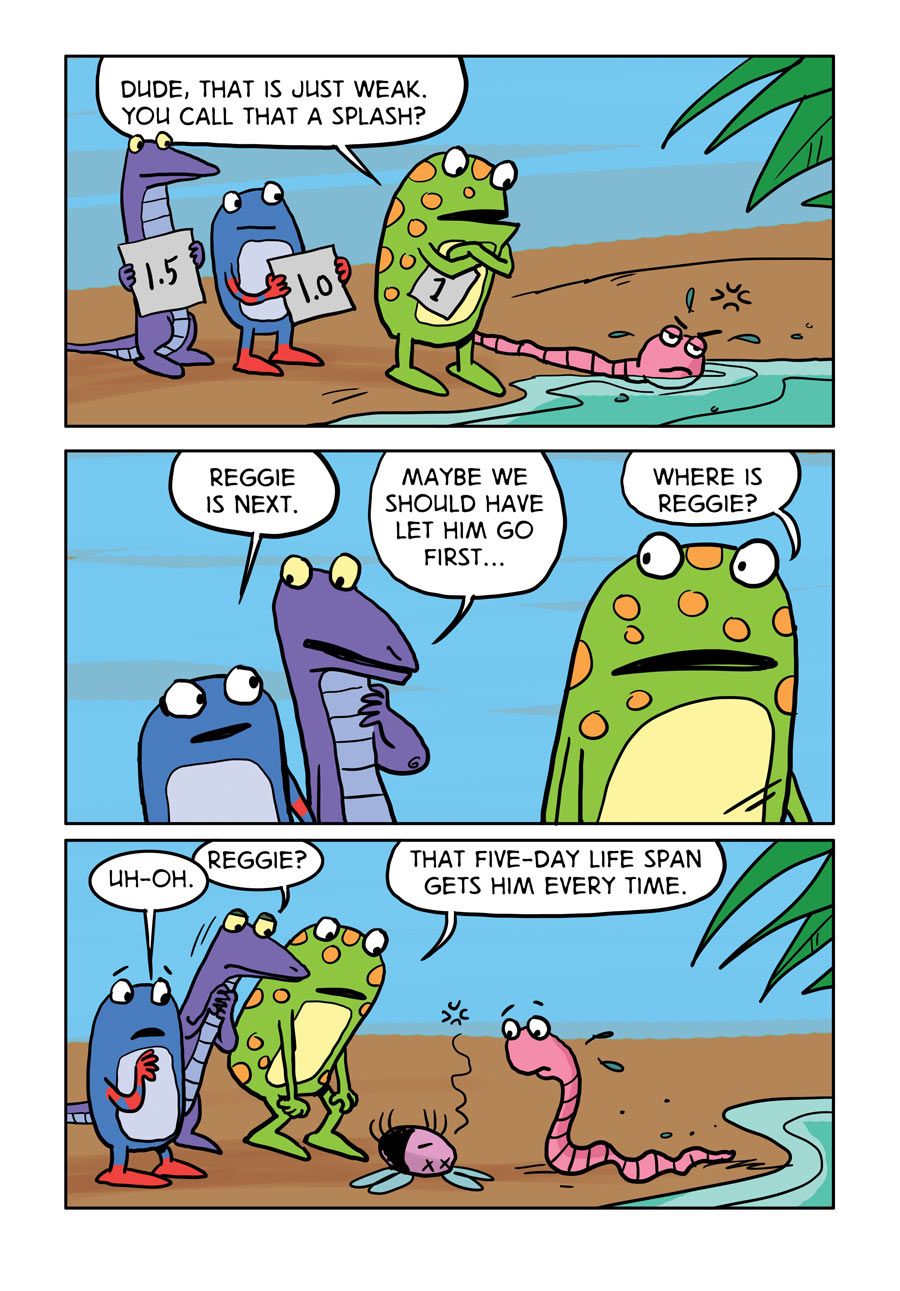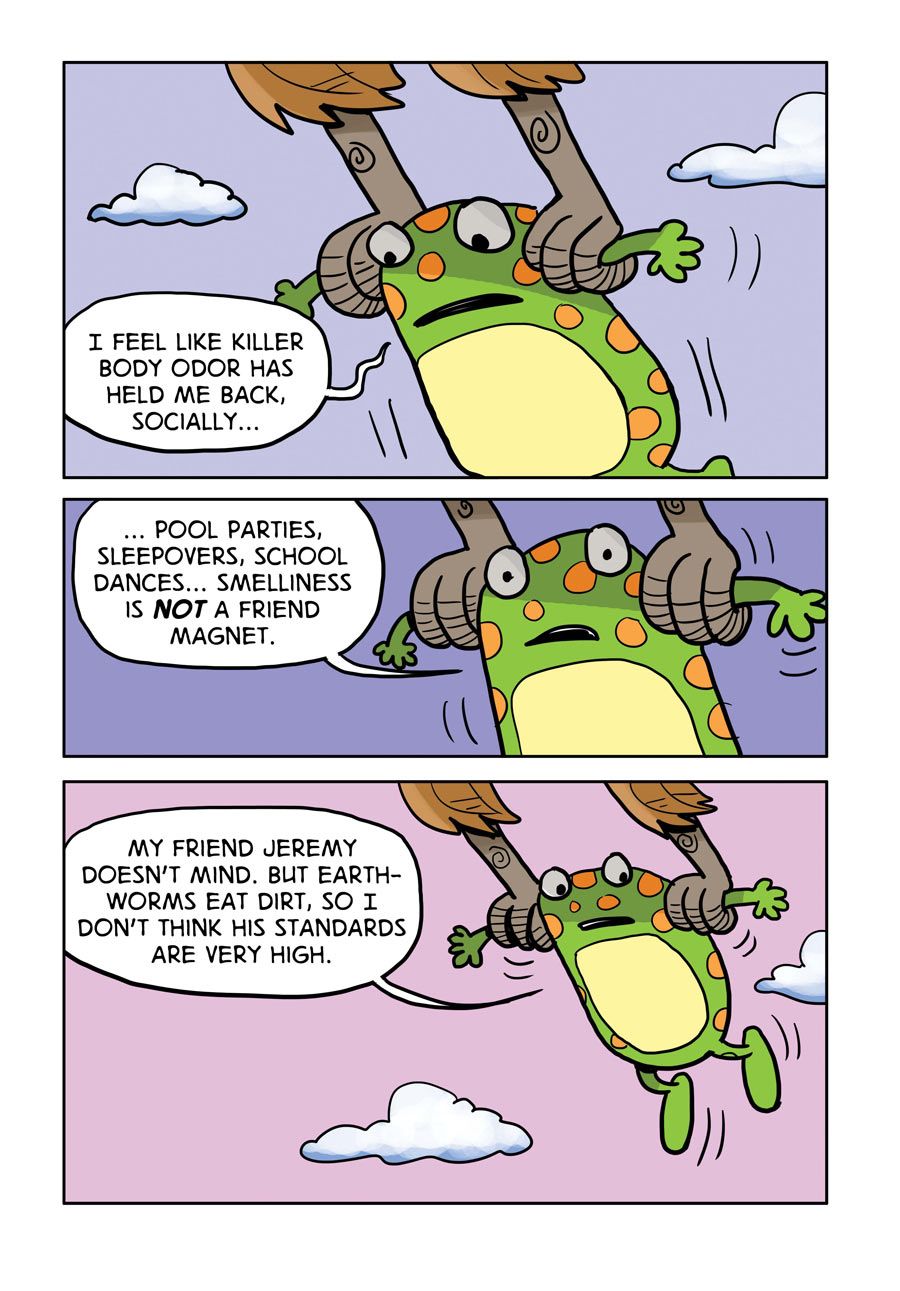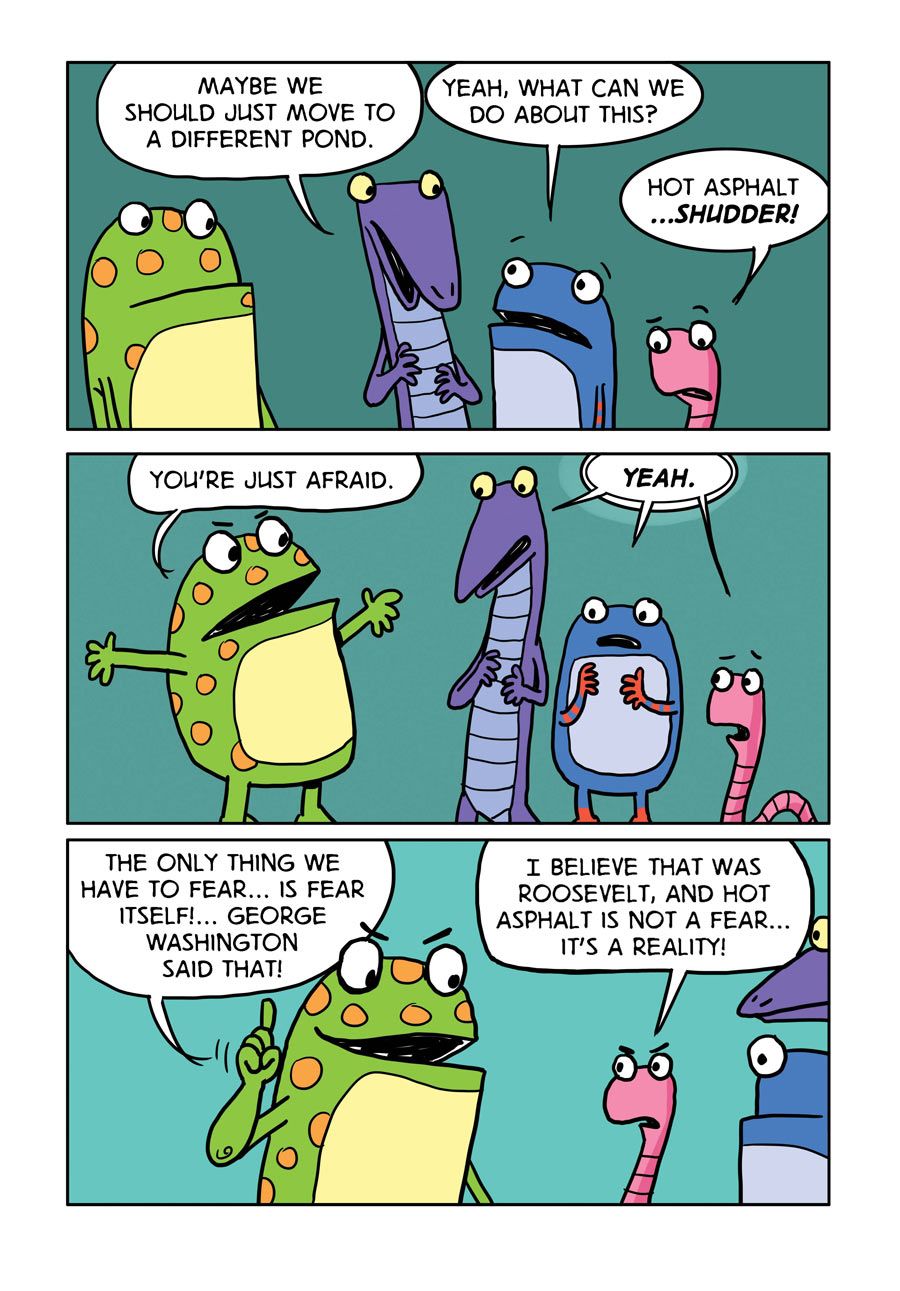As the cartoonist behind the strip "Jane's World," Paige Braddock has enjoyed a lengthy career. She's been working on the strip since it debuted in 1991, taking time along the way to dip her toe into the world of graphic novels, like "The Martian Confederacy." In the late '90s, Braddock was hired by the late Charles Schulz to work in his studio. Following Schulz's death, Braddock became the Creative Director of Charles M. Schulz Creative Associates, where she is one of the people who works on the monthly "Peanuts" comic book and a number of original graphic novels released by BOOM! Studios.
This year, Braddock finished "Stinky Cecil in Operation Pond Rescue," a children's book which was just published by Andrews McMeel. "Stinky Cecil" tells the story of the denizens of a pond, including Reggie, a fly with a five-day lifespan; Jeff, a free range hamster; and others, all of whom find themselves confronted with a road project that threatens their home and way of life. A different sort of project for Braddock, we recently spoke with her about the book, safeguarding the "Peanuts" legacy, the anticipated animated film arriving later this year, and much more.
CBR News: "Peanuts" is one of those strips that simple, but not simplistic. How do you think that has affected your own work, and I'm thinking in particular of "Stinky Cecil," which owes more to that approach than a lot of your other work.
Paige Braddock: I think working on "Peanuts" has made me a better cartoonist. I don't know why exactly. Maybe it's just that you soak it in by being here. Looking at the strip every day. Working on projects where you're adapting artwork that ["Peanuts" creator Charles] Schulz did you get really focused on his design and how he balanced panels. You realize that you don't have to overdraw everything. What people are attached to when they read Peanuts is the authenticity of the characters. The character's voice. Who they are. Your drawing then becomes a heartfelt representation of that.
Cecil is super simple, but I really tried to get nuances of emotion in his mouth and eyes, and you realize from working on "Peanuts" that you can do that pretty simply. It's weird to say because it's somebody else's work, but there are things that rub off on you. Just his storytelling and how his characters talk and act in a way that's not predictable and have depth.
Where did the idea for "Stinky Cecil" come from?
I started out posting it [online] as a comic strip, which was originally titled "Apocalypse Pond." I was going to meet with this editor in Kansas City, Andrea Colvin, to talk about "Peanuts" books. She had Googled me before we had this meeting, and she stumbled across the comic. We talked about, could it be developed into something for kids, and then obviously we had to change the name because "Apocalypse" is a little dark for third graders. Plus, it's hard to spell. That's how it became "Stinky Cecil."
How did you approach the book? Because it is a different type of project for you.
I don't think the humor was necessarily dumbed down for kids. I just wrote what I thought was funny. A couple people who read "Jane's World" have said that they see Cecil has some Jane moments. I'm sure there's a similar humor style crossing over between the books.
Beyond just a different subject matter, the book is also a departure, stylistically speaking.
I purposefully made the artwork really simple because I knew that it was going to be in color, and I wanted the color to have room to breathe. Also, a friend of mine that works at Pixar told me that kids respond really well to characters that are simple enough for them to draw. I was really conscious of that when I was coming up with the character designs. It's funny how many kids have drawn them. I've gotten fan art -- we did a show at the Schulz Museum, and kids left drawings of Cecil and the worm in the museum's guest book. I think that was very good advice.
My favorite character is Reggie the fly, who has a five-day lifespan. Where did this idea come from? It's one of those ideas that skirts edge of being too dark for kids.
I actually wondered if that would make it in the book, the fact that he has a five-day lifespan. When I give talks to kids, kids laugh so hard at that. He is blissfully unaware that he only has a five-day lifespan. That's part of his charm. You can only evolve so much when you're only alive for five days, so he's always going to come back as a fly, but he's happy about that. He doesn't know any different. He's good comic relief, too, because of all the gross things that flies do -- and kids are really into gross things. [Laughs]
It was funny, because in writing the book, I did research about each species in the book. How is a toad different from a frog? How long is a toad's lifespan? How long do earthworms live? This way, I could make jokes based on real-world things. That worms really do eat dirt and they don't have arms so there are all these things they can't do. Teachers seem to like that.
Did you have the story and the structure of the book figured out from the beginning?
Not really. I had a much longer and much more complex story, and the editor said, I really think we should break this into two books. They paired me up with an editor, Sheila Keenan, because I'd never done a kids book before, and she had been at Scholastic and had done a lot of kids books. She helped me understand, psychologically, where kids are at that age we were targeting, what matters to them and what sort of stories they get invested in. One of those things is, at their age, they don't feel very empowered. A story that would be appealing to them is one where the characters aren't very empowered, but somehow manage to save themselves or help themselves. Or discover at some point that they have the ability to save themselves and they didn't know it. That gave me a push in the right direction as far as what the story resolution should be. I had some idea about where some outside force comes in and saves them, and she said, it would be good if they save themselves.
What do you have planned for the second book?
It's going to be even funnier than the first book. I told my editor, picture "Single White Female," but with amphibians. She started laughing and asked, "So what does that mean exactly?"
The title is "Terrarium Terror." Cecil gets captured by a third grade science class and gets put in a terrarium with a super-needy chameleon named Nesbit, who basically is the worst suckup you could ever imagine being around. He changes his color to match Cecil's. He tries to be like Cecil. It's basically "Single White Female," except with amphibians. There are so many funny things about chameleons I didn't know until I was researching it that make him so creepy and annoying. There are so many physical gags you can do that are based in science that I think teachers will like. The gags just write themselves. [Laughs]
As we alluded to earlier, in addition to your work on "Stinky Cecil" and "Jane's World," you have a day job as the Creative Director of Charles M. Schulz Creative Associates. What does entail? I know that Mr. Schulz originally hired you in the '90s, and I'm sure that your job has changed since then.
The job has changed a lot. When I first started, Sparky -- Mr. Schulz -- was still here, doing the comic every day. He hired me to recreate all the kids books that had been done over the years based on the animated specials. He wanted to update those. Also, he wanted to have somebody on staff that he could delegate a lot of the licensing art to. Say a lunchbox manufacturer is doing a lunchbox and they don't quite have the art right, he wanted somebody he could hand that to help them fix it.
Then, of course, after he passed away, it became a different sort of job. When he was here, he was the creative director. We still review every Peanuts item. We work in conjunction with our licensing office in NYC, Peanuts Worldwide. They handle sales and contracts and legal. Once that part is done, products get submitted here, to the studio. Anything that gets produced anywhere in the world comes through this studio. Right now, because we have the movie coming out in November, we have about 10,000 active pieces in our approval system. Since October, it's been that high. We normally have about five to six thousand pieces in the system at a time. I've got a staff under me, and this is what we do. We manage Peanuts products. We're looking at editorial content, the use of the characters, promotion association with other products. You name it.
The one thing about the movie which is really different from anything I've ever worked on before is that we're going to have this whole different look to the characters because they're being done in CG by Blue Sky. That's been an interesting change.
I was going to ask about that. Most people have likely seen the movie preview, but now you have tie-ins and items done in the movie style as well. How does that work?
We were involved upfront, getting on board with what the characters look like. Once that was approved, Blue Sky took the lead on developing the art that gets released to licensees to use on product. The interesting thing was deciding what era to base that on. Craig Schulz is the lead on the project, and this was his baby -- he's one of the writers. Early on it was like, okay, if you're going to do a Peanuts movie, and you're going to start from scratch, and you're going to build CG characters that have never been built before, what era are you going to place them in? After the movie comes out, Peanuts is going to have three looks: the classic Bill Melendez painted cell animation, all Sparky's work, and then this modern CG work that Blue Sky came up with.
They've been very true to Schulz's work. The last time I was at the Blue Sky studio was when they were really nailing down what the characters faces were going to look like. You would think, okay, Peppermint Patty looks like this. Well, not really. Schulz was never drawing the strip so that every single drawing was uniform. Every day, things would change in very subtle ways. The animators would have this sheet of like two hundred Peppermint Patty drawings to make a decision about what was the quintessential Peppermint Patty expression. When I looked at that, I was like, dude, no way could I be an animator. I do not have the patience for that.
Comics is so much more organic, because you're one person writing a strip that's going to be in the paper for one day. That's what Schulz was doing. He wasn't thinking about, "Oh, I should draw Charlie Brown so that when he's rendered in 3D, he turns perfectly." Which he doesn't! I think the "making of" book will be really interesting because they'll probably talk about all the cheats they had to do to make the characters work in 3D.
Like you said, we're used to seeing the characters 2D -- both in the comic strips and in the animated specials -- and they don't really work in 3D.
Bill Melendez had the same problem. You can see it when you watch the older animated specials. There'll be a jump between a three quarter view to a side view, because there is no in-between. [Laughs]
2015 is the 65th anniversary of "Peanuts." The movie is coming out in the fall, but you've also been co-writing and inking a lot of the comic books from BOOM!, including the 25th issue that just came out.
We are doing an original graphic novel for later this year, too. I'm very excited about that. A guy who works here, Jason Cooper, is going to be writing it. He's been doing a lot of the stories in the monthlies and he has a really, really good ear for the sensitivity that Schulz put into stories. I think that's going to turn out nicely. Vicki Scott is going to pencil it again. She's amazing. Saying I write and draw "Peanuts," for me it's like, not really. I basically ghost Schulz. I pull all his good lines. [Laughs] Then I ink Vicki's awesome pencils. These books make me look great.
Since I've been here so long, I do have an ear for when things get off track, when the ending of the story doesn't quite work. I think early on in the series with BOOM!, we had some hits and misses in terms of that. It's really hard to duplicate the tone of "Peanuts'" humor, because Schulz was never slapstick. You can have some physical comedy, but if you don't balance that out with the heartfelt part of "Peanuts," then it doesn't ring true. It doesn't feel right.
"Peanuts" has a very precise tone. It's melancholy, but not too melancholy. It's funny, but not too wild. There's physical comedy, but it's not slapstick.
It's biting, but not acerbic. It's very subtle. It's sarcastic sometimes, but not in the way that some modern comics are. It doesn't have that edge to it. It's very subtle.
It's easy to tell when you get it wrong, but it's hard to get it right.
Jason has a really good ear for that. I'm not sure why that is, but he really does.
As far as the comic books, is most of the work for those done within the studio?
Yes. The family was -- I wouldn't say they were uncomfortable with the idea, because "Peanuts" had done comic books before, back in the '60s. It wasn't like we were breaking totally new ground, but they wanted control, so we keep a lot of it in house. BOOM!'s been great to work with. If Jeannie Schulz has a concern, they're very good about listening to that. I think they want to make sure that the family's happy with the end result.
So right now you're working on all the "Peanuts" projects, you're still doing "Jane's World," you're working on the next "Stinky Cecil" book.
There's a "Jane's World" novel that's going to be out next year from a publisher called Bold Strokes Books. It should be pretty funny. Basically, her roommate talks her into changing over from PayPal to this new Earth-friendly company called PayBuddy. Of course her account gets hacked, and she purchases a mail order bride from a country that used to be part of the USSR. Anyway, she doesn't even know it until the chick shows up with her rolling luggage on her front porch. [Laughs]
So you're staying busy.
I'm busy, yeah. [Laughs] "Cecil" came out of nowhere, and maybe this is the best way to create a concept. I was doing so much work and I had all these other projects with deadlines, I was like, I want to do something that I believe in and do it because it's fun. I'm not going to try to sell it. I'm not going to try to make it commercial. I'm just going to do it because it's fun. That's how Cecil started, and I think that comes through in the book. Andrews McMeel are great to work with. I learned a ton of stuff from Sheila Keenan. I can only say good things about the whole project, from start to finish.

